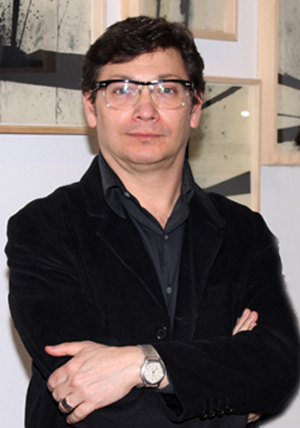|
Claudio Cretti was born in 1964 in Belem, PA. As a baby, he moves with his family toPirassununga, in the countryside of São Paulo, where he lives until he is 15 years old. Growing up within a rural setting had a lasting impression on him. In 1979, he moves to the city of Sao Paulo, and two years later enrolls in the technical school IADE - Instituto de Arte e Decoração. There, during his formative years, he starts to further define his artistic practice. While in school, he develops apprenticeships with professors such as Lenora de Barros, Guto Lacaz and Cássio Michalani, among others.
In 1984, he enrolls at the Escola Belas Artes for fine arts, but abandons the program before completing his first year.
In 1985, working in theatre, he collaborates in works with the Grupo Ponkã, headed by Paulo Yutaka. He performs in the play O próximo Capítulo and conceptualizes the performance Criptoprismática presented at the III Salão Paulista de Arte Contemporânea, for which he receives the award, Prêmio Estímulo, at the Pinacoteca do Estado anda the Funarte, in São Paulo.
In 1986, he works on the play Bodas de Sangue, by García Lorca, with the group Dramáticos. At the same time, he starts to sketch regularly, sending works to studios. He also studies oriental medicine and complete a diploma as a massage therapist from the Associação de Massagistas Orientais.
In 1987, he enters the Setor Educativo da Fundação Bienal and works as an educator at the 19ª Bienal Internacional de São Paulo, under the guidance of Tadeu Chiarelli and Chakè Ekizian. Working in artistic and educational projects, he meets contributors and collaborators who he works with until this day. Also in that year, he performs Aceita um Chopp, Duchamp? and presents at the Bienal de São Paulo.
In 1988, he starts to work on the Projeto Enturmando, by the Secretaria do Estado do Menor, hosting art workshops for at risk youth. The following year, he takes over operations of the project that goes on to last until 1992.
In 1989, he has his first solo exhibition at Funarte São Paulo. He also develops na Art History course with critic Rodrigo Naves.
In 1990, he has three exhibitions, one solo and two group shows at the Centro Cultural São Paulo. From then on, he starts to regularly exhibit his artwork.
In 1995, he starts to teach at the Escola da Vila, in São Paulo, where he continues to teach to this day.
In 2003, he goes on to coordinate the educational department and member services with the Ação Educativa at the Instituto Tomie Ohtake, where he stayed until 2008. Today, he serves as a consultant for the same institution.
In 2004, he receives an invitation to present a solo exhibition at the Paço das Artes in São Paulo. A documentary on his production of the series O mundo da Arte, is created by TV Cultura and the rede SESI-SENAC.
In 2006, he presented a large exhibition, Onde pedra a flora, at the Estação Pinacoteca em São Paulo.
In 2008, he has a solo exhibition, Luz de ouvido at the Palácio das Artes in Belo Horizonte.
In 2009, by invitation of the Galeria de Arte Marilia Razuk in São Paulo, he conceptualizes and presentes the group show Desenhar Lugares. In the same year, he creates the publication José Antonio da Silva, a children’s book on the titled artist.
|
|

Works:
|
